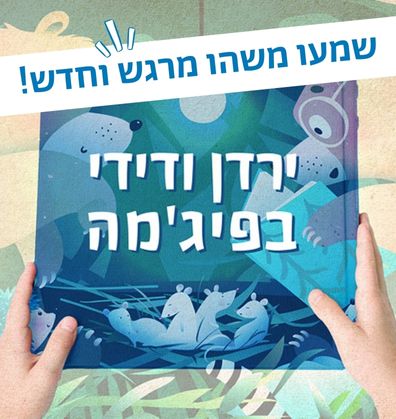אֲנִי וְעַצְמִי
עצמאות
ילדים וילדות מפתחים תחושת עצמאות כחלק בלתי נפרד מתהליך הגדילה. ספרים בהם הגיבורים נדרשים לעצמאות אישית ומתנסים בה, יכולים לעודד ולחזק ילדים להתנסות במשימות שונות וללמוד שהם מסוגלים. מתוך הזדהות עם דמויות שונות ועם מצבים שונים מעוררי השראה, אפשר לפתח נקודות מבט חדשות. מוזמנים ליהנות יחד מסיפורים על המצאות ועל התנסויות שונות, על תסכול ועל גבורה, ועל התמודדויות עצמאיות עם אתגרים, שמעצימות את תחושת המסוגלות ואת חדוות הגילוי.
סְּפָרִים
Book-Related Family Activities
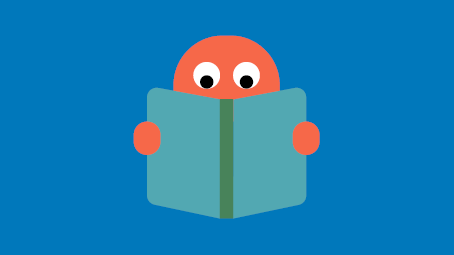
Family reading advice
When children first learn to read, they put tremendous effort into following the sequence of letters and flow of words. When they listen to adults — who are close to them — read to them, they can free themselves of the effort, and indulge in imagining the story or discovering new things about the book. It is, of course, recommended that children be encouraged to read on their own, but, at the same time, you should also keep reading together.

Discussion – Learning from experience
Have you ever tried building or planning something that didn’t quite come out the way you intended? How do we feel when things don’t come out quite the way we planned? What can help us in such cases? You can share with your children your own experiences when things didn’t quite go as planned, and what heled you cope.

QR code
Listen to this episode called A Great Idea, which is part of a podcast called Yarden and Didi in Pajamas in partnership with Kan Podcasts, Keren Grinspoon Israel and the Israeli Ministry of Education.

Building together
What happens when we plan first and then build? Or when we build without planning? You can try it both ways using items you have collected, Lego pieces, or anything else you have at home, and see how you feel and what the result is each time.
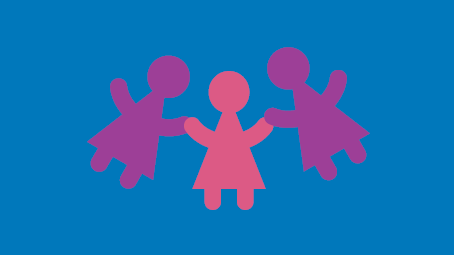
Drawing from our imagination
You can play an imagination drawing game. Take turns describing to the rest of your family as follows: In my imagination I see something that does… It has a… and it’s the color of… – while the rest of your family follows your description and draws it on paper. What does each drawing look like? How fascinating!

Tip for Family Reading
Children enjoy feeling all grown up. While reading a book, let your children play a part, and enhance their sense of capability: You can ask them to select a book off the shelf, hold it, turn the pages, or even tell you or one of the stories in their own words.

I Can’t
Avivi tells her mother that she cannot tidy up her room because she is too small. After reading this book, you can discuss and think together – is it easy or hard to tidy up your room? What can help you tidy it up? What are you able to do now that you were not able to do in the past because you were “too small” to do it?

Tidying up before the time is up!
You can have fun and try to break a “family record” in tidying up a room: Place various toys and items in the main room of the house, set a timer, or decide when the time will be up. Ready? Set? Go and work as a team to put all the items back where they belong as fast as you can! How long did it take? Did you finish before the time was up?
Puppet Theater
Avivi asks her toys to tidy up the room, but they say they can’t – the teddy bear is too tired, and the frog is too lost… How about your toys? What are they unable to do and why? What would you like to ask them to do? You can put on a show with puppets and toys, making up various day-to-day situations or tasks for them to do together.
Family Reading Advice
The encounter with different illustration styles develops toddlers’ sensitivity to color and aesthetics, as well as their attention to detail. The illustrations in this book have been placed into boxes, much like a comic book. While reading, you can help your toddlers follow the plot by pointing at the right box, and asking questions about the details that appear in it.
Sharing House Chores
You can discuss with your toddlers and ask: Do they help around the house? How? What other chores would they like to take part in? How do they feel when they do things around the house themselves? Are some things too hard? You can talk about your own experiences – the kinds of things you learned to do when you were their age.
Listen to the Story
Listen to Didi and Yarden read this book on the Sifriyat Pijama podcast.

Fun Tasks
You should think of a house chore that your toddlers can take part in and turn it into an experiential game. For example: Taking all the socks that have just been washed and dried, pulling one over your hand, and having it help you look for its mate; or turning vegetable-rinsing into a vegetable “shower” under the faucet, or a “bath” in a bowl.

Egg-Ball
Suggest that your toddlers experiment the various ways that Yehoshua attempted to bring the egg by using a ball – throwing and catching it, placing it on your head, holding it and running… You can also try different-sized balls, or soft or hard ones, while noticing what each one feels like.
Family reading advice
Reading independently:
While reading, toddlers can participate and feel all grown-up and independent. They can choose the book, hold it and turn the pages, point and say words they know. Encouraging toddlers to participate in reading will bolster their sense of capability, and enhance their connection to the world of reading.

Doing things on my own:
You can discuss the things that toddlers learn to do by themselves, and ask: What do you do at home all by yourself? What do you need help doing? Are there things you would like to learn to do on your own? How can we practice something new that you would like to learn how to do?
Characters for Print
Print out the characters from this book, cut them out, stick them onto popsicle sticks, and act the story out yourselves, or make up what happened on the eighth day in the book using these characters.
Download Here! 🐞⚫🔴

Illustrations
The illustrations contained in this book are full of details. You can look for a new detail every time you read it, just like Tim Tam finds a new dot each day. Where is Tim Tam? Where are the black dots? What other shapes can you notice? Which animals appear on each page? Which items can be found at Tim Tam’s house?

Looking for dots
Tim Tam learns to notice the dots around he and find them. You can look for dots and round objects together in your surroundings. Where are the dots hiding? Perhaps on your shirt? Your body? Which round items do we have at home? You may even encounter one of Tim Tam’s ladybug friends.

A ladybug finger:
Use two fingers to lightly tap your child’s arm, leg, or face, and travel along it like a ladybug. Where does it feel nice? Where does it tickle? Where can you feel it more, and where can you feel it less?
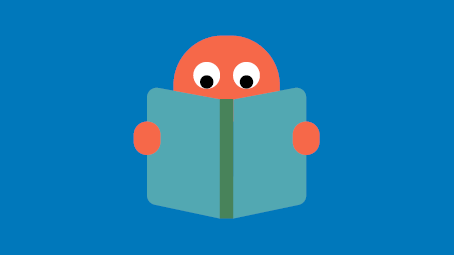
Family reading advice
Toddlers enjoy reading books together, and when they focus on the story, they use their learning, concentration and imagination abilities. To “get into” the story and allow them to concentrate, you should disconnect from the world for a few minutes, sit somewhere calm, with no background noises, screens or mobile phones, and fly together on the story’s wings.

פעם אני החתול ופעם אני החתולה
This short book is full of experiences from toddlers’ day-to-day lives: They want to take part, sometimes they experience rejection, they strive to be independent and are busy finding solutions. You can discuss such moments in the story with your toddlers and link them to their world: What did the girl cat want? How did she feel when the boy cat didn’t want her to join him? What did she decide to do? Do you also enjoy going out for a walk? And what do you like doing all by yourself?
Let’s go for a walk!
You can suggest packing a small bag and going for a walk with your toddler, just like the girl cat, in your home or neighborhood. Together, you can think of all the things you need to take with you on your walk – a bottle of water? A hat? How about a toy?

What do the illustrations tell us?
When you look at the illustrations together, you could focus your attention on different things each time – Where is the boy cat? And where is the girl cat? What are they doing? Which items can you identify in the picture?
Family reading advice – Finding your own way
Who says that stories must be read at bedtime? Maybe you prefer reading them in the afternoon? Or lying together on the rug, or having a stuffed toy join you while reading? Every toddler has his or her own personality and needs, and grownups, of course, have their own preferences too. You can look for the best reading time and method for you and your toddler, and create your own special story hour.
Reading with movement
While you read, you can shoo the fly away together with your toddler, just like the child in this story: You can clap, jump with your entire body, or move only your hand, or sneeze ever so loudly, and then look right and left for the fly that flew away.
QR code
Would you like to sing with the fly that got lost? Scan the code and listen to the song the “Fly That Got Lost”. You can dance, fly, and make buzzing sounds together.

The buzzing finger
Your finger can become a fly too: Make buzzing sounds and wiggle your finger in the air as if it were a fly. You can see your toddler following the “flying” finger. You can place your finger on another area of your toddler’s body each time: his or her nose, cheek, arm or ear. You can say: “Buzz on the forehead” out loud, while going over the names of their body parts and laughing together. Once your toddler has become familiar with this game, you could invite him or her to make a finger a fly too.
Family reading advice – The recurring phrase
Many books for toddlers have a recurring phrase that helps them follow the storyline and play a part in the reading. To emphasize the recurring phrase while reading this book, you can use a special voice, add a hand gesture, or change your reading pace. When the familiar phrase comes up, your toddlers will be delighted to join you.
Ora Ayal [1946-2011] was a children’s writer and illustrator. She illustrated over 70 books, among them Miriam Roth’s well-known books, as well as writing some herself, such as A Girl Alone and One Dark Night.

Discussion – Who do we love visiting?
Visits are a significant part of a toddler’s world. We visit family and friends, and sometimes, they visit us. You can discuss and ask: Who did we visit? What did we do during our visit? Who shall we invite over to our house?

Who will we meet next?
At the corner of each page there is an illustration that hints at the encounter we will see on the following page. Before you turn the page, you may want to look at the illustrated clue and guess who will be waiting for you on the following page. You can even play with real-life objects: Cover an item almost entirely, and ask your toddler what is hiding under the cover – a teddy-bear? Hat? Or purse?

What is in the illustration?
The final page of the book is a story in itself, containing many illustrated details. You may enjoy looking for the many details in the illustrations that you have come across throughout the book: a dog, girl, hat or flower. You can even try to identify and name the items at Grandma’s house: Where is the kettle? What is hanging on the wall?
Family reading advice
Reading books is a wonderful way to get to know a child’s world. When reading, you may want to pause every once in a while, and allow your child to respond to the events depicted in the book: How do the characters feel? How do we, as readers, feel? Has something similar ever happened to you?

Discussion – large and small
Have you ever helped to make a salad? Have you ever fallen and hurt yourself? You may enjoy recollecting together, parents and children, moments when you felt big, and managed to do something all on your own, and other incidents when all you wanted was to be hugged and comforted. This may be a good opportunity to get to know your child’s experiences, while sharing special moments with them from your own childhood.
Is it better to be big or small?
What is better? Scan the QR code to sing along with your child and think what is better – being big or small?
Looking at the illustrations
While reading, you may enjoy looking at the illustrations and searching for interesting details: What is Matan doing? How many animals can you spot? Who is large and who is small? Where can you see a cat? And which of the illustrations is your personal favorite?

Big or small?
Pick up two objects and compare them – which of them is small and which is big? Now, replace one of the objects with another, and check again: Is the teaspoon big or small when compared to a bottle cap? And what happens when it is next to a broom? You can use yourselves as one of the objects and check whether you are big or small. And what happens when you stand next to other family members?

Reading advice: Befriending a book
Reading books from a young age contributes greatly to toddlers’ development. Starting to read slowly and gradually is recommended. At first, toddlers may be allowed to connect to the book in their own way: Touch it, open and close it, look at the illustrations, and become curious. Later, you can read: Read a little each day, patiently and calmly. Some toddlers will prefer to be read a single page, get familiar with it until – hey – books have become their friends!
What happens along the way
We can make interesting discoveries if we only pay a little attention. You may enjoy discussing what you see as you walk or take a drive: “Here is a red car!” “I see clouds. What do you see?” You can also share experiences with your toddler: “On my way to work today, I saw a lady walking her dog. What did you see on your way or back from daycare?”
Why read with toddlers?
Scan the QR code to discover how books’ contribute to toddlers’ development.

Morning ritual
Like the boy in the book, all toddlers enjoy rituals that generate a fixed routine, calm them down, and help them start their day feeling good and happy. You can also have your own morning ritual. For example, you can encourage your toddler to say good-bye a beloved stuffed toy: “Teddy, Teddy, I’m going to Kindergarten, goodbye!”, while you parents reply on behalf of the bear: “Goodbye! See you later! Have a safe journey!”

Encountering animals
Many animals appear in the book. You can look at them together, and state their names, make the relevant sounds, and mimic their movements: Crow like a rooster, hop like a bunny, or gallop and neigh like a horse. You can also look at the illustrations on the final page, cover one of the animals each time, make the relevant sound or mimic its movements, and have your toddler guess which animal it is.
Reading with Toddlers
How do we turn books into friends? Reading from a young age contributes greatly to toddlers’ development. We suggest starting slowly, gradually, and age-appropriately: Some toddlers will want to touch the book, open and close it, or even “taste” it. You can then read a little, patiently and enjoyably. You can start by reading one page, and, as you get used to it, add more pages, until, hey – books have become friends!
Reading together – Good Morning
While reading, you can emphasize the words good morning using a special voice and welcoming gesture. Invite toddlers to join in, follow the story, and take an active part in the reading. You can create your own good morning greetings: “Good morning kitchen chair!” “Good morning tree on our street!”, “Good morning, Bobby the dog!”

Observing the world
For toddlers, everything can be a teachable moment. Time spent together going to or from daycare provides an opportunity to observe what attracts toddlers’ attention: Is it ants walking in a row? A large truck? Or perhaps a flock of birds?
Activities You Can Do at Home
- Flip through the pages of the book together and ask your children to tell you the story in their own words, using the illustrations as guides.You may also choose dolls or stuffed animals to represent Aliza and her friends, and enact the story together.
- Everyone feels lazy at times. You can discuss this together: when do we find it hard to do things? Maybe it’s when we first get out of bed in the morning, or when we have to do chores we don’t like?
- Sometimes young children are actually mature enough to perform certain tasks by themselves, but they don’t do sobecause they’reaccustomed to getting help. You and your children could brainstorm about which tasks you tend to do for them—and then choose one task that they can now do all by themselves. Be sure to give them positive feedback when they show you how independent they can be!
- Who are Aliza the duck’s friends? Who are your children’s friends? And who are your friends? Think of the things that Aliza and her friends enjoy doing together, and then share how you spend time with your friends, and have your children tell you what they like to do with their own friends.
- You could bake a cake together and invite friends over for a tea party, just as Aliza the duck and her friends do at the end of the story.
- If you know the fable: “The Grasshopper and the Ant,” you could tell it to your children.
We hope you enjoy reading and discussing together this book!
האם הילדים מכירים קומיקס?
האם הילדים מכירים קומיקס? סיפור קומיקס, או “עלילון”, הוא בעצם סיפור כפול: הרפתקאותיו של אורי כדורי כפי שמתוארות במילים, ועלילת הציורים. לא צריך לדעת לקרוא כדי לפענח טורי קומיקס! ילדי הגן יוכלו “לקרוא” את הציורים ולספר את הסיפור במילים שלהם.
להסב את תשומת לב הילדים לכלב הגדול שלמלווה את אורי ברוב הרפתקאותיו
כדאי להסב את תשומת לב הילדים לכלב הגדול שלמלווה את אורי ברוב הרפתקאותיו. הכלב לא מוזכר בסיפורים, והוא פרי דמיונה של המאיירת רותו מודן. אפשר לשוחח עם הילדים, מה עושה הכלב בסיפורים?
לצייר טור קומיקס
ילדי הגן יכולים גם לצייר טור קומיקס. ניתן לבקש מהם לבחור סיפור מוכּר ולהכין ממנו קומיקס.
משחק: כל אחד בוחר חפץ בחדר ועושה בו שימוש מצחיק ובלתי-שגרתי
אחד הדברים המצחיקים ב”אורי כדורי” הוא השימוש הבלתי-שגרתי בחפצים מוכּרים. אפשר לשחק משחק: כל אחד בוחר חפץ בחדר ועושה בו שימוש מצחיק ובלתי-שגרתי. על השני לנחש לְמה הפך החפץ המוכּר.
לשאול את הילדים מה הם ממציאים ולבקש שיתבוננו בתמונות ויגלו מה החליט אורי לעשות.
אורי כדורי ממציא פתרונות מגוחכים לבעיות שונות (כיצד להתייבש לאחר הגשם, מה לעשות בקליפת בננה כשאין בסביבה פח, איך להתאים את גובהו של כסא לשולחן…). אפשר לקרוא את סיפורונים יחד ולעצור לפני הפתרון, לשאול את הילדים מה הם ממציאים ולבקש שיתבוננו בתמונות ויגלו מה החליט אורי לעשות.
לשוחח בקבוצות קטנות
האם עלילותיו של אורי כדורי הצחיקו את הילדים? איזה סיפור אהבו במיוחד? אפשר לשוחח בקבוצות קטנות, לבחון את הפרטים הקטנים שבאיורים ולאפשר לילדים להביע את העדפותיהם.
מפגש בדיחות וצחוק
בעקבות הקומיקס ולקראת חג פורים אפשר לערוך יחד עם ההורים “מפגש בדיחות וצחוק”, עם סדנאות לכתיבת קומיקס, שעשועים וחידות, ושירים היתוליים.
יצירות נוספות שכתבה לאה גולדברג
האם ילדי הגן מכירים יצירות נוספות שכתבה לאה גולדברג (למשל, “איה פלוטו?”, “דירה להשכיר”, “הילד הרע” ועוד)? אפשר להכיר לילדים את דמות היוצרת ולערוך תצוגה בגן. כדאי לבקש מהילדים לחפש בבית ספרים ושירים פרי עטה ולצרף אותם לתצוגה.
לספר את העלילה במילים
לא צריך לדעת לקרוא כדי לפענח טורי קומיקס! ילדיכם יוכלו “לקרוא” את הציורים ולספר את העלילה במילים שלהם.
להכין קומיקס
גם ילדים צעירים יכולים לצייר טור קומיקס. ניתן לבקש מילדיכם לבחור סיפור מוכּר ולהכין ממנו קומיקס.
לשחק משחק: כל אחד בוחר חפץ בחדר ועושה בו שימוש מצחיק ובלתי-שגרתי
אחד הדברים המצחיקים ב”אורי כדורי” הוא השימוש הבלתי-שגרתי בחפצים מוכּרים – למשל, כאשר אורי כדורי תולה את עצמו על חבל הכביסה, או מושיט חכה כדי לדוג דג זהב מתוך אקווריום. אפשר לשחק משחק: כל אחד בוחר חפץ בחדר ועושה בו שימוש מצחיק ובלתי-שגרתי. על השני לנחש לְמה הפך החפץ המוכּר.
לקרוא שוב את הקומיקס ולשאול את ילדיכם, מה הבעיה ומה הפתרון בכל סיפור?
כל אחת מעלילותיו של אורי כדורי עוסקת בפתרון מגוחך לבעיה שעומדת בפני הגיבור. אפשר לקרוא שוב את הקומיקס ולשאול את ילדיכם, מה הבעיה ומה הפתרון בכל סיפור? יחד תוכלו להמציא עוד פתרונות מצחיקים לבעיות.
מה מצחיק אתכם?
מה מצחיק אתכם? בעקבות הקומיקס ולקראת חג פורים אפשר לערוך “ערב בדיחות וצחוק” במשפחה.
יצירות נוספות שכתבה לאה גולדברג
האם אתם מכירים יצירות נוספות שכתבה לאה גולדברג? אפשר לחפש בבית, בספריית הגן או בספרייה המקומית ספרים ושירים פרי עטה וליהנות יחד גם מהם.
Family Activities:
- You can flip through the book together with your children, looking at OraAyal’s heartwarming illustrations and pointing out each of the occasions on which the blanket helped Maya. You might ask your children what they think made the blanket change its size as the story went along.
- Like Maya, many children have a “lovey” (rag, blanket, pacifier, stuffed animal, or doll) that they take with them everywhere. Talk with your children about the strong attachment Maya feels for her “Blankie,” and share your own experiences: When you were young, did you have a favorite object to which you were particularly attached? Do your children have one? Perhaps you, too, want to embark on a “journey” with the item and do some growing with its support.
- Maya really wants to be four years old already. You could ask your children if there are things “big kids” do that “little kids” don’t. Together you could make an illustrated listof your children’s achievements and capabilities: things they know how to do today andcouldn’t do a year ago, and what they would like to be able to do when they are older.
- You might discuss special occasions throughout the year: holidays, the first or last day of school, important events in the life of your family. How do you mark all these occasions? Do you recite the Shehehiyanublessing, and if so – when?
- How does your family celebrate birthdays? Maya’s story underlines the point that maturity is measured not only by how old you are, but also by your actions. After reading the story, you might add a new custom to your family birthday celebrations—one that will give your children a chance to display their new-found maturity. You could suggest that they choose a toy, an item of clothing, or a doll or stuffed animal that they no longer need “because they’re big,” and give it away to a younger child.
- You could also hold a birthday party for one of your children’s dolls or stuffed animals – plan the party, make decorations, sing songs… everything you do for a birthday!
- Young children’s perception of time is not yet fully developed, and many children, like Maya, ask, “When will…?” Working together, you could design a weekly calendar showing all the days of the week, and then mark each passing day with a small picture or sticker.
Family Activities:
- Together with your children, take the time to look closely at Na’ama Benziman’s beautiful illustrations. You may want to stop at the page where Emilia approaches the three steps leading to the preschool, and note the changes in her facial expression.
- After reading the story, you can make up your own fantastic story and draw it.
- Emilia really wanted to enter the classroom on her own, “without any problems and without making a scene”. You and your child can look at the first illustration in the book, that depicts Emilia saying good-bye to her mother, and compare the entrance to her classroom with your child’s schoolyard. What helps your child say good-bye and go into the classroom in the morning? Do you have a special ceremony or technique that eases the separation? After reading the story about Emilia, you may want to invent a new way to say good-bye in the morning, a way that will help your child feel grown-up and brave.
- Like Emilia, each one of us feels sometimes big and other times small. You can read the story together again and take note of the points in the plot when Emilia feels big and when she feels small. You might ask your child when they feel big and small, and emphasize the advantages of each condition.
- Emilia’s friend Dana enters the story at precisely the moment when Emilia is feeling lonely. You can use this as an opportunity to talk about friendship. You might ask: What do we like to do together with our friends, when do we prefer to be alone and what is more enjoyable to do together with others?
- Dana is very happy to see Emilia, and they play together. You too can play together and even make your own tea party like the girls in the story. What will you serve at your tea party, who will be big and who will be small? You can invite other family members, dolls or stuffed animals to join your party.
- You can recount all the things your child knows how to do alone, and some tasks he or she needs help with. You might want to share an experience of your own, and tell your children about a time when you overcame an obstacle on your own – and when you were helped out by family or friends.
- Emilia’s journey into the classroom is depicted like a dream. You might want to talk to your child about dreams. Do you remember your dreams? You can try to draw a picture of one of the dreams you or your child dreamt.
- You may want to take this opportunity to share one of your own childhood experiences with your child. Did you attend preschool? If so, do you remember being sad saying good-bye in the morning? With whom did you play, and what did you like to do with your friends? You might want to compare your preschool with your child’s current classroom.
רעיונות שהציעה נעמה בנזימן לפעילויות עם הילדים סביב האיורים שבספר
לחצ/י כאן לרעיונות שהציעה נעמה בנזימן לפעילויות עם הילדים סביב האיורים שבספר
You may want to read the story several times
You may want to read the story several times, enjoying together the rhyming games and opposites, and accompanying Miriam on her quest for the sea. After several readings, your child will probably be able to complete the sentences, and “read” the story themselves.
Does your child know the sea?
If you do not have a beach close by, you could spend some time at the pool, fill a tub in the back yard, or even have a bath. Take simple seaside playthings along with you, such as a funnel, sieve, and various sized plastic bottles. Have fun!
Miriam's questions contain many opposites
hot–cold, big–small, old–new etc. You may enjoy playing an opposites game together. One of you could ask the other: “Is it ______ (hot, big, old…)?” and the other could reply: “No, it’s ________ (cold, small, new..)!”
You may enjoy playing the "warm-cold" game together
One of you thinks of an object in the room, and leads the other toward it using clues of “warmer” (the object is close by) or “colder’ (the object is far away).
Following the story, you may like to have a conversation with your child about seasons,
Following the story, you may like to have a conversation with your child about seasons, and discuss how our activities change in winter when it is raining outside, and in summer, when it’s hot out.
Mirik Snir wrote dozens of wonderful books for young children
Mirik Snir wrote dozens of wonderful books for young children. You may want to look for them, at home or the library, and read them together
Find the animals
Yossi Abulafia has put some entertaining details in the illustrations that aren’t mentioned in the story. Try to find the dog and the cat on each page. Did you find them? What are they doing? What sort of expression do they have on their faces? You could try imitating the facial expressions and movements of both the dog and the cat. What else did you find in the illustrations? Do your children know the names of the different objects?
Dad and Noam, you and your children
Nira Harel tells us which games Noam likes: playing ball, hugging his teddy bear, and playing ‘pretend’ games. You and your children can play ‘pretend’ together. Each one takes a turn pretending to be Noam—saying “That one!” while pointing to something in the room. The family member pretending to be Noam’s Dad then tries to guess which object is meant. At the end of the game everybody hugs and laughs, just like in the story.
There is nothing like a sense of humor to defuse tension in moments of frustration
There is nothing like a sense of humor to defuse tension in moments of frustration. Next time you are struggling to understand what your children are saying, try remembering “That One!” Recall the father’s sense of humor and the funny illustrations. Then maybe when your children ask for “that one,” a loving hug will help you, too?

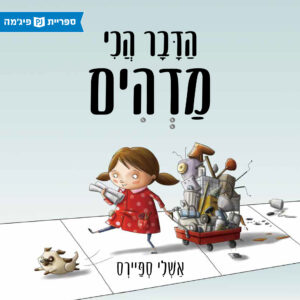 The Most Magnificent Thing
The Most Magnificent Thing 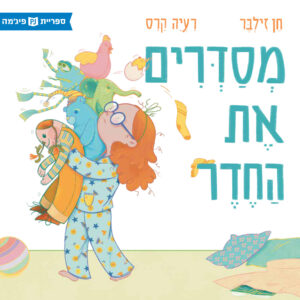 Tidying Up the Room
Tidying Up the Room 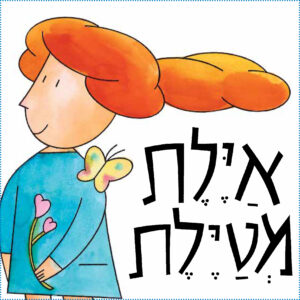 Ayelet Takes a Walk
Ayelet Takes a Walk 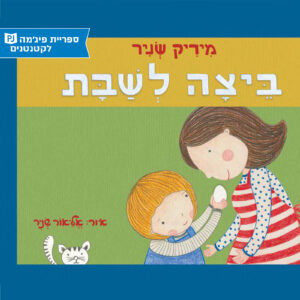 An Egg for Shabbat
An Egg for Shabbat 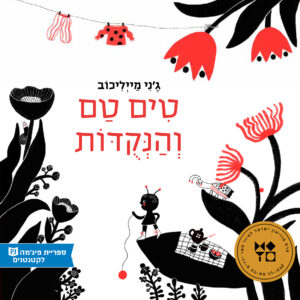 Tim Tam and the Spots
Tim Tam and the Spots 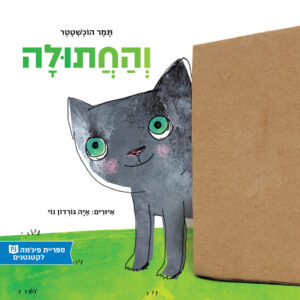 And the Cat
And the Cat 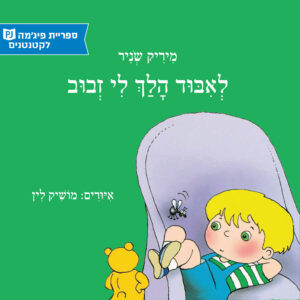 The Fly That Got Lost
The Fly That Got Lost 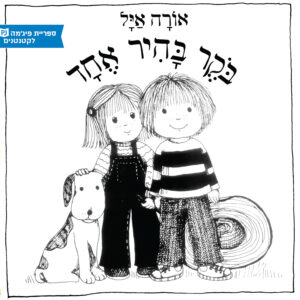 One Bright Morning
One Bright Morning 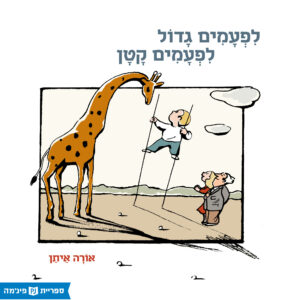 BIG OR SMALL
BIG OR SMALL 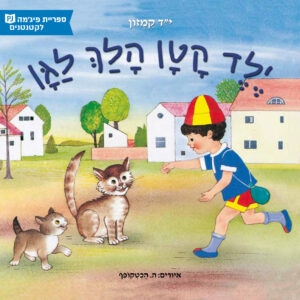 A Young Boy Went to Kindergarten
A Young Boy Went to Kindergarten 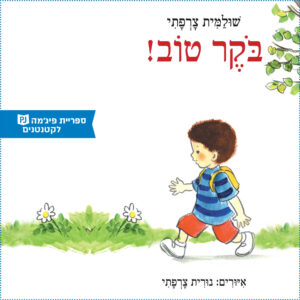 Good Morning!
Good Morning! 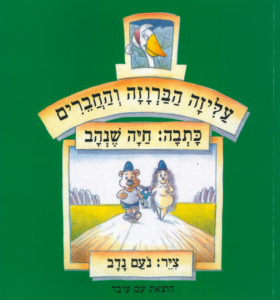 Aliza the Duck and Friends
Aliza the Duck and Friends 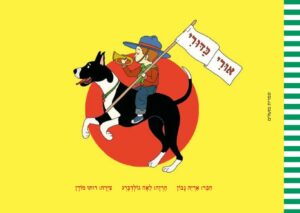 Uri Kadori
Uri Kadori 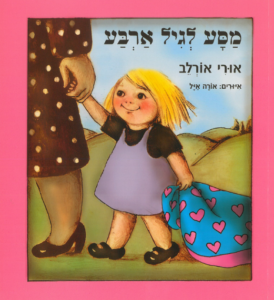 Journey to Age Four
Journey to Age Four 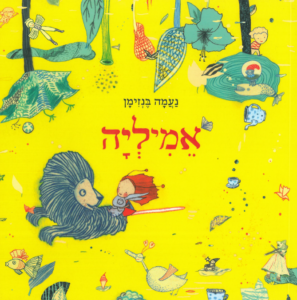 EMILIA
EMILIA 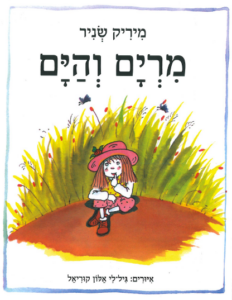 Miriam and the Sea
Miriam and the Sea 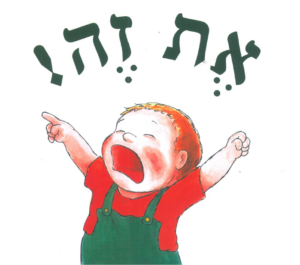 That One!
That One! 














